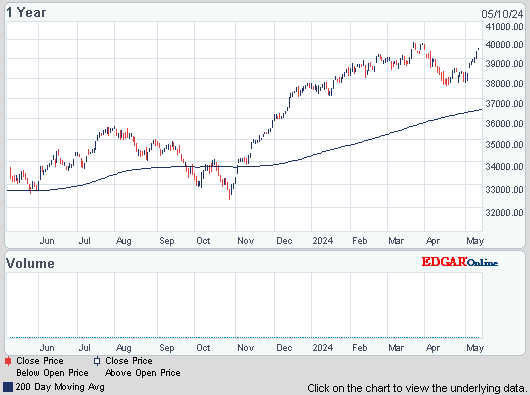Dow was up 106 (but off the highs), advancers over decliners 3-2 & NAZ climbed 29. The MLP index rose 1+ to the 464s & the REIT index continued weak, falling 2+ to 299. Junk bond funds (stocks with high yields) were mixed while Treasuries pulled back, taking the yield on the 10 year Treasury to a 1 year high over 2.1%. Oil was strong along with the markets & gold fell on signs the Federal Reserve may curb US monetary stimulus.
AMJ (Alerian MLP Index tracking fund)

![Live 24 hours gold chart [Kitco Inc.]](http://www.kitco.com/images/live/gold.gif)

Directors at the Federal Reserve (FED) district banks last month saw moderate growth for a US economy buoyed by the housing market while facing risks such as the deadlock over federal spending. “Job growth was described as modest, on balance, and the unemployment rate remained elevated,” according to minutes released today. Directors “expressed concern that unresolved fiscal issues could be restraining hiring and economic growth more broadly.” The minutes summarize discussions among board members at the 12 regional reserve banks as they consider whether the FED should alter the discount rate that it charges on emergency lending. The discussions were considered by its Board of Governors on Apr 8 & Apr 29. The board made no change to the discount, which has been at 0.75% since Feb 2010. Directors at the Kansas City Fed last month repeated a request for a quarter-point increase in the discount rate to 1%, while directors at the other 11 banks voted to keep the rate unchanged. Some directors supported increasing the rate to 1% “as a step toward restoring the pre-crisis discount rate structure,” according to the minutes. “These directors favored a move toward normalization of the primary credit rate in light of current and anticipated economic conditions.”
Fed Regional Bank Directors Saw Moderate Growth Amid Fiscal Risk
European leaders are worried about youth unemployment & called for more help for businesses to help solve the problem that has left nearly one in 4 young people without a job. At a conference, French, Italian & German ministers warned that if high youth unemployment is not addressed, young people will lose faith in their govs & the EU. European countries have seen their unemployment rates skyrocket, first fueled by the global recession & then by their debt crisis. The unemployment rate for the EU's 27 member countries is now 10.9%. For young people in Europe (aged 15-24) the situation is much worse with an unemployment rate of 23.5%. In Greece & Spain, youth unemployment is over 50%. By comparison, it is 16.1% in the US (ages 16-24). EU countries have struggled to tackle the problem. Budget cuts imposed to control outsized deficits, which have cut have thousands of public-sector jobs & left little money for economic stimulus or employment programs. Countries with the worst unemployment problems, like Greece, Spain & Italy, are implementing labor market reforms that should eventually spur growth & create more jobs by making it easier for companies to hire and fire people, but they will take a long time to yield results.
EU leaders sound the alarm on youth unemployment AP
Moody's raised its outlook for the US banking industry for the first time in 5 years, citing the improving economy & banks' stronger balance sheets. It said that sustained economic growth & a better jobs picture will help banks over the next 12-18 months. Moody's raised its outlook for the industry to "Stable" from "Negative." It had been "Negative" since 2008, the year the financial crisis struck. After a year of reducing losses from soured loans & building cushions against losses, banks are in a better position to handle any future economic downturn. Moody's added the most likely scenario pushing the outlook back to negative would be a slackening of banks' credit standards.
Dow is up an astounding 560 in May. Aside from a few dreary days last week, it has been pretty much straight up as has been the case for the last year. Last Jun 4, it stood at 12,101. Today it's 3300 higher, for one of its biggest rises in history. Longer term, it's up over 130% since the recession lows in early 2009 while the US has had one of its slowest recoveries ever. GDP got off to a mediocre start in Q1 & may have only mediocre in Q2. However, the bulls are not concerned & they are in control of the stock market.
Dow Jones Industrials

AMJ (Alerian MLP Index tracking fund)
Treasury yields:
U.S. 3-month |
0.04% | |
U.S. 2-year |
0.28% | |
U.S. 10-year |
2.13% |
| CLN13.NYM | ...Crude Oil Jul 13 | ...95.10 | (1.0%) |
![Live 24 hours gold chart [Kitco Inc.]](http://www.kitco.com/images/live/gold.gif)

Directors at the Federal Reserve (FED) district banks last month saw moderate growth for a US economy buoyed by the housing market while facing risks such as the deadlock over federal spending. “Job growth was described as modest, on balance, and the unemployment rate remained elevated,” according to minutes released today. Directors “expressed concern that unresolved fiscal issues could be restraining hiring and economic growth more broadly.” The minutes summarize discussions among board members at the 12 regional reserve banks as they consider whether the FED should alter the discount rate that it charges on emergency lending. The discussions were considered by its Board of Governors on Apr 8 & Apr 29. The board made no change to the discount, which has been at 0.75% since Feb 2010. Directors at the Kansas City Fed last month repeated a request for a quarter-point increase in the discount rate to 1%, while directors at the other 11 banks voted to keep the rate unchanged. Some directors supported increasing the rate to 1% “as a step toward restoring the pre-crisis discount rate structure,” according to the minutes. “These directors favored a move toward normalization of the primary credit rate in light of current and anticipated economic conditions.”
Fed Regional Bank Directors Saw Moderate Growth Amid Fiscal Risk
European leaders are worried about youth unemployment & called for more help for businesses to help solve the problem that has left nearly one in 4 young people without a job. At a conference, French, Italian & German ministers warned that if high youth unemployment is not addressed, young people will lose faith in their govs & the EU. European countries have seen their unemployment rates skyrocket, first fueled by the global recession & then by their debt crisis. The unemployment rate for the EU's 27 member countries is now 10.9%. For young people in Europe (aged 15-24) the situation is much worse with an unemployment rate of 23.5%. In Greece & Spain, youth unemployment is over 50%. By comparison, it is 16.1% in the US (ages 16-24). EU countries have struggled to tackle the problem. Budget cuts imposed to control outsized deficits, which have cut have thousands of public-sector jobs & left little money for economic stimulus or employment programs. Countries with the worst unemployment problems, like Greece, Spain & Italy, are implementing labor market reforms that should eventually spur growth & create more jobs by making it easier for companies to hire and fire people, but they will take a long time to yield results.
EU leaders sound the alarm on youth unemployment AP
Moody's raised its outlook for the US banking industry for the first time in 5 years, citing the improving economy & banks' stronger balance sheets. It said that sustained economic growth & a better jobs picture will help banks over the next 12-18 months. Moody's raised its outlook for the industry to "Stable" from "Negative." It had been "Negative" since 2008, the year the financial crisis struck. After a year of reducing losses from soured loans & building cushions against losses, banks are in a better position to handle any future economic downturn. Moody's added the most likely scenario pushing the outlook back to negative would be a slackening of banks' credit standards.
Dow is up an astounding 560 in May. Aside from a few dreary days last week, it has been pretty much straight up as has been the case for the last year. Last Jun 4, it stood at 12,101. Today it's 3300 higher, for one of its biggest rises in history. Longer term, it's up over 130% since the recession lows in early 2009 while the US has had one of its slowest recoveries ever. GDP got off to a mediocre start in Q1 & may have only mediocre in Q2. However, the bulls are not concerned & they are in control of the stock market.
Dow Jones Industrials










No comments:
Post a Comment